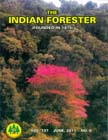Ethnobotanical Practices of Tribals in Achanakmar Amarkantak Biosphere Reserve
DOI:
https://doi.org/10.36808/if/2011/v137i6/12373Keywords:
Ethnobotany, Exploitation, Local Inhabitants, TribalsAbstract
The study was conducted on documentation of utilization of products of plant resources by local inhabitants of Achanakmar Amarkantak Biosphere Reserve (AABR) district Bilaspur, Chhattisgarh. Twenty six tree species were found in the study site and their products were collected and utilized for domestic and commercial purposes. Tree species come under sixteen families and the abundance of families of tree species were in the order of Anacardiaceae, Combretaceae and Euphorbiaceae. The study revealed that the demand for tree species like Buchanania lanzan (Char), Syzygium cumini (Jamun), Emblrea officinalis (Aonla), Aegle marmelos (Bael), Diospyros melanoxylon (Tendu) and Semecarpus anacardium (Bhelwa) etc. has alarmingly increased in the recent past due to their multiple uses and commercial exploitation. Few useful tree species such as Shorea rubusta (Sal), Terminalia alata (Saja), Madhuca indica (Mahua), Diosp yros melanoxylon (Tendu), T. chebula (Barra), T. beUirrea (Bahera), Cleistanthus collinus (Karra), Semecarpus anacardium (Bhelwa), Syzygium cumini (Jamun), Lannea coromandelrea (Gunja) and Anogeissus latifolia (Dhawra) are observed in the area. The study emphasized to conserve and domesticate these tree species for improving the livelihood oflocal inhabitants.Downloads
Download data is not yet available.
Downloads
Published
2011-06-01
How to Cite
Singh, L., Kasture, J. A., Singh, U. S., & Shaw, S. S. (2011). Ethnobotanical Practices of Tribals in Achanakmar Amarkantak Biosphere Reserve. Indian Forester, 137(6), 767–776. https://doi.org/10.36808/if/2011/v137i6/12373
Issue
Section
Articles
License
Unless otherwise stated, copyright or similar rights in all materials presented on the site, including graphical images, are owned by Indian Forester.





